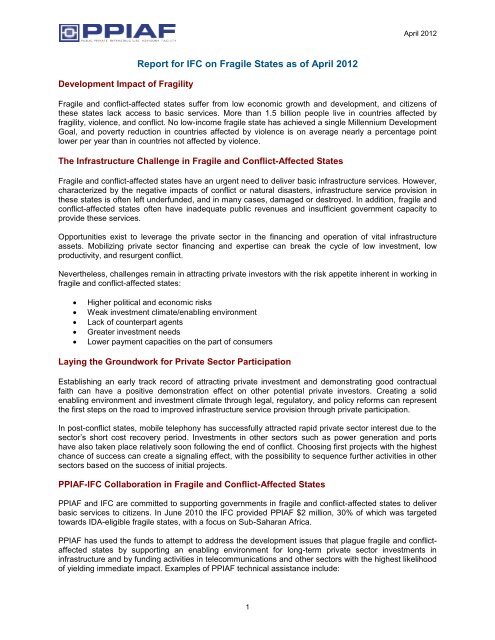PMR cover.psd - ppiaf
PMR cover.psd - ppiaf
PMR cover.psd - ppiaf
Create successful ePaper yourself
Turn your PDF publications into a flip-book with our unique Google optimized e-Paper software.
Development Impact of Fragility<br />
Report for IFC on Fragile States as of April 2012<br />
1<br />
April 2012<br />
Fragile and conflict-affected states suffer from low economic growth and development, and citizens of<br />
these states lack access to basic services. More than 1.5 billion people live in countries affected by<br />
fragility, violence, and conflict. No low-income fragile state has achieved a single Millennium Development<br />
Goal, and poverty reduction in countries affected by violence is on average nearly a percentage point<br />
lower per year than in countries not affected by violence.<br />
The Infrastructure Challenge in Fragile and Conflict-Affected States<br />
Fragile and conflict-affected states have an urgent need to deliver basic infrastructure services. However,<br />
characterized by the negative impacts of conflict or natural disasters, infrastructure service provision in<br />
these states is often left underfunded, and in many cases, damaged or destroyed. In addition, fragile and<br />
conflict-affected states often have inadequate public revenues and insufficient government capacity to<br />
provide these services.<br />
Opportunities exist to leverage the private sector in the financing and operation of vital infrastructure<br />
assets. Mobilizing private sector financing and expertise can break the cycle of low investment, low<br />
productivity, and resurgent conflict.<br />
Nevertheless, challenges remain in attracting private investors with the risk appetite inherent in working in<br />
fragile and conflict-affected states:<br />
� Higher political and economic risks<br />
� Weak investment climate/enabling environment<br />
� Lack of counterpart agents<br />
� Greater investment needs<br />
� Lower payment capacities on the part of consumers<br />
Laying the Groundwork for Private Sector Participation<br />
Establishing an early track record of attracting private investment and demonstrating good contractual<br />
faith can have a positive demonstration effect on other potential private investors. Creating a solid<br />
enabling environment and investment climate through legal, regulatory, and policy reforms can represent<br />
the first steps on the road to improved infrastructure service provision through private participation.<br />
In post-conflict states, mobile telephony has successfully attracted rapid private sector interest due to the<br />
sector’s short cost re<strong>cover</strong>y period. Investments in other sectors such as power generation and ports<br />
have also taken place relatively soon following the end of conflict. Choosing first projects with the highest<br />
chance of success can create a signaling effect, with the possibility to sequence further activities in other<br />
sectors based on the success of initial projects.<br />
PPIAF-IFC Collaboration in Fragile and Conflict-Affected States<br />
PPIAF and IFC are committed to supporting governments in fragile and conflict-affected states to deliver<br />
basic services to citizens. In June 2010 the IFC provided PPIAF $2 million, 30% of which was targeted<br />
towards IDA-eligible fragile states, with a focus on Sub-Saharan Africa.<br />
PPIAF has used the funds to attempt to address the development issues that plague fragile and conflictaffected<br />
states by supporting an enabling environment for long-term private sector investments in<br />
infrastructure and by funding activities in telecommunications and other sectors with the highest likelihood<br />
of yielding immediate impact. Examples of PPIAF technical assistance include:

















